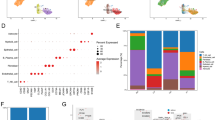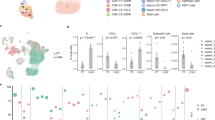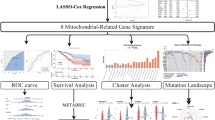Abstract
The outcome of breast cancer patients with supraclavicular lymph node metastasis is generally poor, but some patients do survive for a long time. Consequently, the ability to predict the outcome is important in terms of choosing the appropriate therapy for breast cancer patients with supraclavicular lymph node metastasis. In this study, we attempted to identify functional pathways that determine the outcome of breast cancer patients with supraclavicular lymph node metastasis by profiling cDNA microarrays. Thirty-one breast cancer patients with supraclavicular lymph node metastasis without distant metastasis comprised the study cohort; these were divided into three groups based on prognosis – poor, intermediate, and good. Two functional pathways, the Wnt signaling pathway and the mitochondrial apoptosis pathway, were constructed using six genes (DVL1, VDAC2, BIRC5, Stathmin1, PARP1, and RAD21) that were differently expressed between the good and poor outcome groups. Our results indicate that these two functional pathways may play an important role in determining the outcome of breast cancer patients with supraclavicular lymph node metastasis. We also determined that immunohistostaining for the Stathmin1 gene product is a potential tool for predicting the outcome of breast cancer patients with supraclavicular lymph node metastasis.
Similar content being viewed by others
Log in or create a free account to read this content
Gain free access to this article, as well as selected content from this journal and more on nature.com
or
Abbreviations
- Sc:
-
Supraclavicular lymph node metastasis
- DMFS:
-
Distant metastasis-free survival
- OS:
-
Overall survival
References
Alli E, Babula JB, Yang JM, Hait WN (2002) Effect of Stathmin on the sensitivity to antimicrotubule drugs in human breast cancer. Cancer Res 62:6864–6869
Brattsand G (2000) Correlation of oncoprotein 18/stathmin expression in human breast cancer with established prognostic factor. Br J Cancer 83:311–318
Chandra D, Choy G, Daniel PT, Tang DG (2005) Bax-dependent regulation of bak by voltage-dependent anion channel 2. J Biol Chem 280:19051–19061
Chen F, Kamradt M, Mulcahy M, Byun Y, Xu H, McKay MJ, Cryns VL (2002) Caspase proteolysis of the cohesin component RAD21 promotes apopsosis. J Biol Chem 277:16775–16781
Cheng EH, Sheiko TV, Fisher JK, Craigen WJ, Korsmeyer SJ (2003) VDAC2 inhibits BAK activation and mitochondrial apoptosis. Science 301:513–517
Deveraux QL, Takahashi R, Salvesen GS , Reed JC (1997) X-linked IAP is a direct inhibitor of cell-death proteases. Nature 388:300–304
Doucas H, Garcea G, Neal CP, Manson MM, Berry DP (2004) Changes in the Wnt signaling pathway in gastrointestinal cancers and their prognostic significance. Eur J Cancer 41:365–379
Goldhirch A, Glick JH, Gelber RD, Coates AS, Thürlimann B, Senn HJ, Panel Members (2005) Meeting highlights: international expert consensus on the primary therapy of early breast cancer 2005. Ann Oncol 16:1569–1583
Guo QM, Malek RL, Kim S, Chiao C, He M, Ruffy M, Sanka K, Lee NH, Dang CV, Liu ET (2000) Identification of c-Myc responsive genes using rat cDNA microarray. Cancer Res 60:5922–5928
He TC, Sparks AB, Rago C, Hermeking H, Zawel L, da Costa LT, Morin PJ, Vogelstein B, Kinzler KW (1998) Identification of c-MYC as a target of the APC pathway. Science 281:1509–1512
Hollander M, Wolfe DA (1999) Nonparametric statistical methods, 2nd edn. Wiley, New York
Kouzu Y, Uzawa K, Koike H, Saito K, Nakashima D, Higo M, EndoY, Kasamatsu A, Shiiba M, Bukawa H, Yokoe H, Tanzawa H (2006) Overexpression of stathmin in oral squamous-cell carcinoma:correlation with tumour progression and poor prognosis. Br J Cancer 94:717–723
Kroemer G, Martin SJ (2005) Caspase-independent cell death. Nat Med 11:725–730
Liu Z, Lu H, Shi H, Du Y, Yu J, Gu S, Chen X, Liu KJ, Hu CA (2005) PUMA overexpression induces reactive oxygen species generation and proteasome-mediated stathmin degradation in colorectal cancer cells. Cancer Res 65:1647–1654
Löhr K, Möritz C, Contente A, Dobbelstein M (2003) p21/CDKN1A mediates negative regulation of transcription by p53. J Biol Chem 278:32507–32516
Nakano K, Vousden KH (2001) PUMA, a novel proapoptotic gene, is induced by p53. Mol Cell 7:683–694
Parton M, Dowsett M, Smith I (2006) Studies of apoptosis in breast cancer. BMJ 322:1528–1532
Patel JH, Loboda AP, Showe MK, Showe LC, McMahon SB (2004) Analysis of genomic targets reveals complex functions of MYC. Nat Rev Cancer 4:562–568
Perou CM, Sotlie T, Eisen BM, Rijin M, Jeffrey SS, Rees CA, Pollack JR, Ross DT, Johnsen H, Akslen LA, Fluge O, Pergamenschikov A, Williams C, Zhu SZ, Lonning PE, Lise A, Dale B, Brown PO, Botstein D (2000) Molecular portraits of human breast tumours. Nature 406:747–752
Sardet C, Vidal M, Cobrinik D, Geng Y, Onufryk C, Chen A, Weinberg RA (1995) E2F-4 and E2F-5, two members of the E2F family, are expressed in the early phases of the cell cycle. Proc Natl Acad Sci USA 92:2403–2407
Shimada K, Uzawa K, Kato M, Endo Y, Shiiba M, Bukawa H, Yokoe H, Seki N, Tanzawa H (2005) Aberrant expression of RAB1A in human tongue cancer. Br J Cancer 92:1915–1921
Song DH, Sussman DJ, Seldin DC (2000) Endogenous protein kinase CK2 participates in Wnt signaling in mammary epithelial cells. J Biol Chem 275:23790–23797
Wieler S, Gagne JP, Vaziri H, Poirier GG, Benchimol S (2003) Poly (ADP-ribose) polymerase-1 is a positive regulator of the p53-mediated G1 arrest response following ionizing radiation. J Biol Chem 278:18914–18921
Zhang T, Otevral T, Gao Z, Gao Z, Ehrlich SM, Fields JZ, Boman BM (2001) Evidence that APC regulates survivin expression: a possible mechanism contributing to the stem cell origin of colon cancer. Cancer Res 61:8664–8667
Acknowledgements
We thank Drs. A. Nakanishi and T. Shimoji and Y. Enomoto and T. Kakita, Japanese Foundation for Cancer Research, as well as Dr. T Osanai, Tokyo Medical and Dental University, for helpful discussions and encouragement. This work was supported in part by Grants-in-Aid for Scientific Research from the Ministry of Education, Culture, Sports, Science and Technology in Japan.
Author information
Authors and Affiliations
Corresponding author
Rights and permissions
About this article
Cite this article
Oishi, Y., Nagasaki, K., Miyata, S. et al. Functional pathway characterized by gene expression analysis of supraclavicular lymph node metastasis-positive breast cancer. J Hum Genet 52, 271–279 (2007). https://doi.org/10.1007/s10038-007-0111-z
Received:
Accepted:
Published:
Issue date:
DOI: https://doi.org/10.1007/s10038-007-0111-z
Keywords
This article is cited by
-
The synergism of SMC1A cohesin gene silencing and bevacizumab against colorectal cancer
Journal of Experimental & Clinical Cancer Research (2024)
-
The multifaceted roles of cohesin in cancer
Journal of Experimental & Clinical Cancer Research (2022)
-
Mutant p53 stimulates cell invasion through an interaction with Rad21 in human ovarian cancer cells
Scientific Reports (2017)
-
Cell cycle inhibition therapy that targets stathmin in in vitro and in vivo models of breast cancer
Cancer Gene Therapy (2013)
-
Enhanced RAD21 cohesin expression confers poor prognosis in BRCA2 and BRCAX, but not BRCA1 familial breast cancers
Breast Cancer Research (2012)



